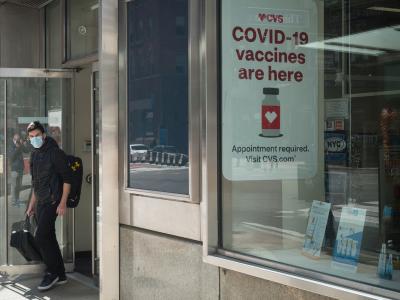Our weekly wrap-up of antimicrobial stewardship & antimicrobial resistance scans
Study: Stewardship program cut antibiotic prescribing by 20 percentage points
An antimicrobial stewardship program (ASP) was tied to a reduction in antibiotic prescriptions for specified non–COVID-19 upper respiratory infections (URIs) from 27.6% to 7.6% over 2 years, according to a study published today in Antimicrobial Stewardship & Healthcare Epidemiology (ASHE).
Researchers from Mayo Clinic Health System-Southwest Minnesota evaluated their ASP, which was designed to reduce antibiotic prescribing for URIs in family medicine, internal medicine, pediatrics, emergency medicine, and urgent care clinics from 27.6% in 2019 to less than 21.6% in 2021. The authors noted that antibiotic prescribing had already begun to drop in 2020, before ASP implementation.
Two urgent-care clinics with more than 300 URI visits per year and an antibiotic prescribing rate greater than 40% (high-priority) were targeted, while all family medicine, pediatric, and adolescent clinics were considered moderate priorities because they had antibiotic prescribing rates of 15% to 57% and only 100 to 300 annual URI visits.
In 2021, an ASP liaison was identified for each high-priority department to receive one-on-one education from the ASP pharmacist and monthly data reports on antibiotic prescribing for their area. Each moderate-priority department received quarterly data summaries.
From October 2020 to February 2021, all departments were given at least one presentation on ASP goals and resources, which included a slide set for provider education, a poster and symptom-management recommendations for patients, and an order panel in the electronic health record system with syndrome-specific guidelines.
As a result, antibiotic prescriptions for URIs fell from 27.6% in 2019 to 19.1% in 2020 and 7.6% in 2021.
The researchers noted that an estimated 44% of antibiotic prescriptions written for outpatients with URIs in the United States are inappropriate and that in 2020, the Joint Commission mandated that accredited institutions implement an outpatient ASP.
"Prioritization of specific departments or providers for ASP intervention based on rate of antibiotic prescribing and total number of encounters of interest may be advantageous in settings with limited ASP personnel," they wrote. "The creation of a provider-specific scoring tool for prioritizing ASP interventions directed toward individual providers may merit future investigation."
Aug 5 ASHE study
After early COVID peak, telehealth antibiotic prescribing for kids quickly fell
Originally published by CIDRAP News Aug 4
A study of data from a large pediatric primary care network found a quick decline in telehealth antibiotic prescribing following a peak during the first 3 months of the COVID-19 pandemic, researchers reported today in Pediatrics.
The study, led by researchers with Boston Children's Hospital, analyzed data telehealth and in-person encounters involving oral antibiotics in a network of 77 independent pediatric primary care practices across Massachusetts from March 2020 to July 2021. Focusing on the top five general diagnosis groupings, the researchers compared patient characteristics between populations that had at least one in-person encounter versus one telehealth video visit with an antibiotic prescribed.
Of the 55,926 encounters with an oral antibiotic prescribed, 12.5% were conducted via telehealth and 87.5% were in person. Patients in the telehealth group were older (median age 11) than patients in the in-person group (median age 9), and were more likely to be commercially insured, White non-Hispanic, and have complex chronic disease. The diagnosis for which an antibiotic was most frequently prescribed during telehealth visits was ear infection (30.8%), followed by skin and subcutaneous infection (21.8%), respiratory infection (18.8%), genitourinary infection (6.3%), and Lyme disease (3.8%).
The proportion of overall telehealth encounters with an antibiotic prescription peaked at 52.1% the week of Apr 27, 2020, then declined to an average of 2.4% over the last 4 weeks of the study period, and trends for individual diagnosis groups were similar, with peaks from March to May 2020 followed by a steady decline. The diagnoses with the greatest proportion of telehealth antibiotic prescribing during the last 4 weeks of the analysis were Lyme disease infections (11.7%) and skin and subcutaneous infections (3.1%).
The study authors say the findings "suggest that pediatricians are fairly self-regulating in their antibiotic prescribing practices and have developed their own norms and practices in which antibiotic prescribing is reserved for in-person encounters in the vast majority of cases."
They also note that the greater persistence of telehealth antibiotic prescribing for Lyme disease and skin and subcutaneous infections may be explained by clinicians feeling more comfortable making these diagnoses virtually. They suggest these conditions could be targets for future research and guideline development.
Aug 4 Pediatrics study
High rate of guideline-concordant antibiotic prescribing for UTIs
Originally published by CIDRAP News Aug 4
A study of women in the US Military Health System (MHS) found high concordance with guidelines for antibiotic treatment of uncomplicated urinary tract infections (UTIs), researchers reported today in JAMA Network Open.
Using healthcare claims data from the MHS Data Repository on women ages 18 to 50 who were treated for uncomplicated UTIs from October 2017 through September 2019, researchers from Johns Hopkins University School of Medicine and the Uniformed Services University assessed antibiotic prescribing patterns and concordance with antibiotic treatment guidelines from the Infectious Diseases Society of America (IDSA).
Previous studies have found that concordance with IDSA guidelines for UTIs ranges from 58.4% to 64.6%, with obstetricians and gynecologists more likely to prescribe a first-line antibiotic than other specialties.
Among 46,793 adult women (67.3% ages 18 to 34, 38.2% White) diagnosed as having an uncomplicated UTI, 91% received IDSA guideline-concordant antibiotic treatment. In comparison with obstetrics and gynecology, IDSA guideline-concordant treatment was more likely in internal medicine (adjusted odds ratio [aOR], 2.87; 95% confidence interval [CI], 2.73 to 3.03), family medicine (aOR, 1.81; 95% CI, 1.76 to 1.87), surgery (aOR, 1.51; 95% CI, 1.36 to 1.67), and emergency medicine (aOR, 1.36; 95% CI, 1.32 to 1.39) and less likely in urology (aOR, 0.40; 95% CI, 0.38 to 0.43). Compared with direct military care, private-sector care had lower concordance rates (aOR, 0.63; 95% CI, 0.62 to 0.64).
Of the 9% of women who received guideline-discordant treatment, the antibiotic overtreatment rate was 5.9%, with higher rates of overtreatment in emergency medicine and family medicine.
The study authors write, "Lower rates of IDSA guideline concordance were seen in obstetrics and gynecology and urology, which could potentially benefit from targeted antibiotic stewardship programs and policies that promote greater adherence to IDSA guidelines."
Aug 4 JAMA Netw Open study
Meta-analysis finds antibiotic use common in COVID-19 patients
Originally published by CIDRAP News Aug 3
In findings that are consistent with previous studies, a systematic review and analysis of 22 studies revealed a high rate of antibiotic use among COVID-19 patients during the first year and a half of the pandemic, despite a low prevalence of bacterial coinfection, researchers reported this week in PLOS One.
To determine the prevalence of bacterial coinfection and antibiotic use among patients with laboratory-confirmed COVID-19, a team of researchers in Scotland reviewed English-language studies published from January 2020 through June 2021. Of the 1,058 studies screened, 22 hospital-based studies were eligible, comprising 76,167 patients. Most of the studies included in the review were conducted in the United States (10), United Kingdom (4), and China (3), with 1 study each in France, Germany, Indonesia, the Netherlands, and Spain. The mean age of patients was 61 years, and 54% of subjects were male.
Random-effects meta-analysis of all combined studies estimated that the prevalence of bacterial coinfection and antibiotic use in COVID-19 patients was 5.62% (95% CI, 2.26% to 10.31%) and 61.77% (95% CI, 50.95% to 70.90%), respectively. Sub-group analysis showed that bacterial coinfection (7.89%; 95% CI, 3.30% to 14.18%) and antibiotic use (68.84%; 95% CI, 62.27% to 75.05%) was highest in North America.
"The results from this review demonstrates that there is insufficient evidence supporting considerable empiric antibiotic prescribing in patients with COVID-19 due to a low prevalence of bacterial coinfection," the study authors wrote. "Nonetheless, antibiotics use was high, mirroring the findings in other reviews. As the pandemic evolves, and new COVID-19 specific therapeutics come into clinical practice, it will be important to assess their impact on antibiotic use."
Aug 1 PLOS One study
VA study shows high antibiotic use during end-of-life care
Originally published by CIDRAP News Aug 3
A nationwide study of Veterans Affairs (VA) patients found high levels of antibiotic exposure during end-of-life (EOL) care, researchers reported yesterday in Clinical Microbiology and Infection.
The retrospective cohort study, conducted by researchers with the Iowa City VA Health Care System and the University of Iowa Carver College of Medicine, analyzed a cohort of VA patients who died from January 2014 through December 2019 and had been hospitalized within 6 months prior to death.
The researchers looked at demographics, comorbid conditions, duration of inpatient antibiotics administered, and outpatient antibiotics dispensed. They then compared antibiotic use in hospitalized VA patients placed into palliative care or hospice versus hospitalized patients who did not receive palliative or hospice care.
Of the 101,208 patients who died during the study period, 9,808 were in hospice care and 40,796 received a palliative care consult, and they were matched to 50,604 patients without palliative or hospice care.
Within 14 days of placement or consultation, 41% (4,040/9,808) of hospice patients and 48% (19,735/40,796) of palliative care patients received at least one antibiotic, while 25% (2,420/9,808) of matched non-hospice and 27% (10,991/40,796) of matched non-palliative care patients received antibiotics. Entry into hospice was independently associated with a 12% absolute increase in antibiotic prescribing (as measured by days of therapy) and entry into palliative care was associated with a 17% absolute increase during the 14 days post-entry versus pre-entry period.
The study authors note that while patients at the EOL are more susceptible to infection, the decision of whether or not to prescribe an antibiotic poses a unique challenge, since it will not likely change the ultimate outcome.
"Rather than focusing on cure, palliative and hospice goals of care typically include minimizing suffering and maximizing quality of life," they wrote. "However, how these goals apply to antibiotic use at the EOL remains unclear."
The authors go on to say that future studies are needed to identify optimal targets during EOL for collaboration between antibiotic stewardship programs and hospice or palliative care teams.
Aug 2 Clin Microbiol Infect abstract
Non-restrictive stewardship intervention tied to less fluoroquinolone use
Originally published by CIDRAP News Aug 2
A non-restrictive antibiotic stewardship intervention was associated with reduced fluoroquinolone prescribing at two community hospitals in Los Angeles, researchers reported yesterday in Open Forum Infectious Diseases.
Based on high fluoroquinolone resistance among common organisms, the association of fluoroquinolones with Clostridioides difficile infection, and documented adverse drug reactions, members of the pharmacy and infectious prevention departments at the two non-academic community hospitals developed strategies to curb excessive use of levofloxacin (LVX), one of the most commonly used antibiotics in the United States.
Because of some of the disadvantages of restrictive policies like pre-authorization, they focused on non-restrictive strategies such as education, monitoring and reporting fluoroquinolone susceptibility trends to physician groups, daily prospective audit and feedback, and implementation of beta-lactam-based institutional guidelines for empiric therapy.
To assess the effectiveness of the interventions, which were implemented in January 2017, researchers collected antibiotic use data from August 2015 through January 2021. Both hospitals showed significant downward trends in LVX prescribing over the study period, and the decrease in LVX use was sustained. At the same time, both hospitals saw an increase in use of ceftriaxone (CRO), which institutional guidelines recommended in place of levofloxacin because of higher susceptibility rates against Enterobacterales. Researchers also observed a positive correlation between reduced LVX days of therapy and reduced Pseudomonas aeruginosa non-susceptibility.
"We speculate the decrease in LVX may result in less adverse drug reactions, along with a higher likelihood of achieving active empiric antimicrobial therapy due in part to CRO's superior susceptibility rates among the Enterobacterales organisms, coupled with a demonstrated improvement in LVX susceptibility among inpatient P. aeruginosa isolates," the study authors wrote. "This was accomplished by targeting prescribing behaviors and the provision of provider feedback and education, which may have less of a negative connotation compared to restrictive approaches."
Aug 1 Open Forum Infect Dis abstract














